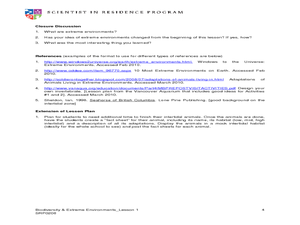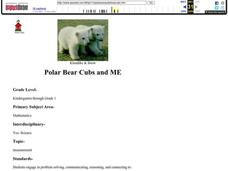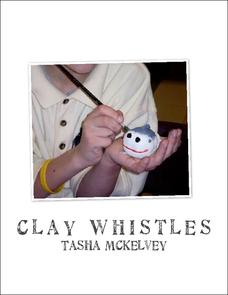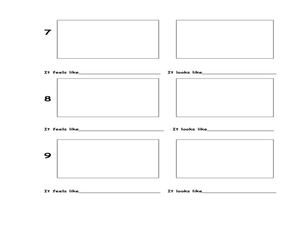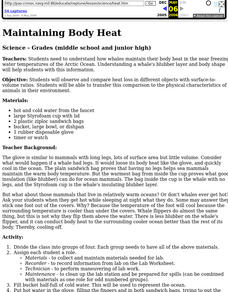Curated OER
Polar Bears
First graders explain what keeps Polar Bears warm in the Arctic by experiencing a layer of blubber to protect them. They read Little Polar Bear by Hans de Beer.
Curated OER
It's not just pretty - it's a survival method!
First graders write explanations for why certain animals can only live in certain environments. In this animal survival lesson plan, 1st graders take pictures of animals and place them into the right environment after a instructional...
Curated OER
Climate Watch
Pupils participate in a national survey of biological indicators of climate change by gathering and submitting data on local plants and animals.
Curated OER
Forest Food Web Activity
Students gain knowledge of food webs and ecological interconnections in the forest, and place different life forms in their proper place in a food chain. Students appreciate the balance of nature and how humans are affected by extinct...
Curated OER
Extreme Environments
Students examine extreme environments and the characteristics that make them. In this adaptation lesson students see how animals have adapted to these environments.
Curated OER
Animal Adaptations
In this animal adaptations worksheet, students will complete a graphic organizer by brainstorming 3 animals and an adaptation that animal has that helps it to survive.
Curated OER
Polar Bear Cubs and ME
Students visit the following web site to find out the birth weights and lengths of polar bear cubs- Ask Jeeves for Kids. They then enter the information found at this site relating to the birth length and weight of polar bear cubs into a...
Curated OER
Help Save the Polar Bear
In this energy conservation instructional activity, students read the poem about saving energy by changing light bulbs to save polar bears. Students may color the bear.
Curated OER
Help Save the Polar Bear
Students use ice cubes to demonstrate how the polar ice caps are melting and how it effects the polar bears. In this polar bear lesson plan, the teacher explains how polar bears live on the north pole and how they are having trouble due...
Curated OER
Observation And Listening Skills
First graders read a story about polar bears and make observations as they read. In this observations lesson plan, 1st graders listen carefully and sing a bear chant.
Tasha McKelvey
Clay Whistles
Create clay whistles with your elementary or middle school young scholars. The project is outlined in great detail here, complete with step-by-step photographs, finished examples, a materials list, student handouts, and a rubric....
Curated OER
Bountiful Biomes
Students research five different biomes while working in groups. They complete a graphic organizer with the information.
Curated OER
Exploring Biomes
In this biology worksheet, students watch a movie about various land biomes. Then they use the word list to the right to complete each of the statements. Students also complete the brief quiz about the movie that follows.
Curated OER
Polar Food Web Comparison
Seventh graders practice the evaluation component of the scientific method while comparing and contrasting the similarities and differences of the food chains and webs of polar animal life. They study about classification and ecology...
Curated OER
Great North
Students use maps to locate the Arctic Circle, the North Pole and Northern Europe. They draw and label countries within the Arctic Cirlce and identify the groups of people who live there. They also watch and answer questions about the...
Curated OER
Great North
Students view a video about the Arctic Circle, North Pole and Northern Europe. They locate areas using a map. They create a drawing of the countries where the Inuit live.
Curated OER
Exploring Habitats
Students analyze the difference between the human habitat and the different habitats of animals in the six lessons of this unit. The students' imaginations and literature are used to explore important aspects of the living environments...
Curated OER
Exploring Marine Objects
Learners identify the sources of water on Earth. In this life science lesson, students list the different plants and animals that live in the ocean. They explore marine objects in the lab and draw them.
Curated OER
Maintaining Body Heat
Students observe and compare heat loss in different objects with surface-to-volume ratios. They transfer this comparison to the physical characteristics of animals in their environment. They focus on how whales maintain their body heat.
Curated OER
Landforms All Around
Students create a "Landform Dictionary". They develop an overlay map and participate in hands-on activities to identify the key characteristics of landforms. They discuss the plant and animal life of these areas. Handouts for the lessons...
Curated OER
For Creative Minds: Mountain Ecosystems
In this mountain ecosystems learning exercise, students read information about mountain ecosystems and study various diagrams about the environment. Students match animals in the ecosystem to their descriptions.
Curated OER
Learning About Mammals
Students study the mammal classification and forms of them living in the United States. For this mammal study lesson, students read through orders of mammals that exist in the United States. Students also study the taxonomy of an eastern...
Curated OER
Walrus
In this animal facts worksheet, students will read information about walruses including where they live and what they eat. Then students will color a picture of a walrus.
Curated OER
Whale Is Stuck
Students engage in the process of problem solving with the help of children's literature story of how the whale was trapped and then freed. The story illustrates the power of teamwork and commitment. The students practice the skill of...
Other popular searches
- Preschool Arctic Animals
- Math Using Arctic Animals
- Unit on Arctic Animals
- Lesson on Arctic Animals
- Arctic Animals Grade K 2
- Arctic Animals Poems
- Books About Arctic Animals
- Art Arctic Animals
- Graphing Arctic Animals
- Arctic Animals Wheel
- Arctic Animals Word Search
- Arctic Animals Crossword






